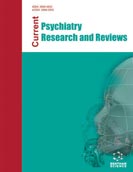Abstract
Aim: This study aims to examine mechanisms that may account for the comorbidity between social anxiety and depression. We hypothesized that maladaptive metacognitions and anhedonia would serially mediate the link between social anxiety and depression.
Methods: We tested this notion by collecting data from 208 international, English-speaking participants ranging from the ages of 18 to 65 years old using the Social Interaction Anxiety Scale (SIAS), Self-Assessment Anhedonia Scale (SAAS), Patient’s Health Questionnaire-9 (PHQ-9), and Metacognition Questionnaire (MCQ-30).
Results: The results show a significant serial mediation effect from social anxiety via beliefs about uncontrollability and danger and anhedonia to depression, with the pathway from social anxiety via reduced beliefs in cognitive confidence and anhedonia to depression not being significant. Furthermore, a direct path from social anxiety to depression was also found to be significant.
Conclusion: Findings support both the tripartite model and the self-regulatory executive function model of anxiety and depression. While the findings imply the contributions of other mediating variables, they also indicate that metacognitive therapy with an additional focus on anhedonia could be effective in preventing the development of depression.
Keywords: Depression, social anxiety, tripartite model, S-REF model, post-event processing, anhedonia, metacognition.
[http://dx.doi.org/10.1016/j.beth.2017.07.003] [PMID: 29029678]
[http://dx.doi.org/10.7573/dic.212573] [PMID: 30988687]
[http://dx.doi.org/10.4103/2249-4863.219992] [PMID: 29302525]
[http://dx.doi.org/10.1016/j.cpr.2007.05.004] [PMID: 17582665]
[http://dx.doi.org/10.1017/S0033291799008375] [PMID: 10405077]
[http://dx.doi.org/10.1016/j.adolescence.2020.05.003]
[http://dx.doi.org/10.1037/0021-843X.100.3.316]
[http://dx.doi.org/10.1016/j.apnu.2013.02.001] [PMID: 23706888]
[http://dx.doi.org/10.1159/000508773] [PMID: 32668436]
[http://dx.doi.org/10.1016/j.comppsych.2016.11.013] [PMID: 28040576]
[http://dx.doi.org/10.1111/sltb.12724] [PMID: 33314250]
[http://dx.doi.org/10.1080/02699931.2017.1289895] [PMID: 28278732]
[http://dx.doi.org/10.1016/S0005-7967(03)00147-5] [PMID: 14998733]
[http://dx.doi.org/10.1016/S0005-7967(96)00050-2] [PMID: 8990539]
[http://dx.doi.org/10.1017/S1352465800015897]
[http://dx.doi.org/10.1375/bech.27.2.69]
[http://dx.doi.org/10.1017/bec.2013.4]
[http://dx.doi.org/10.1017/bec.2015.4]
[http://dx.doi.org/10.1016/S1077-7229(01)80021-3]
[http://dx.doi.org/10.3758/BRM.41.4.1149] [PMID: 19897823]
[http://dx.doi.org/10.1207/s15327906mbr2603_7]
[http://dx.doi.org/10.1111/1467-8721.ep10768783]
[http://dx.doi.org/10.1016/s0005-7967(99)00131-x]
[http://dx.doi.org/10.1016/S0005-7967(97)10031-6] [PMID: 9670605]
[http://dx.doi.org/10.1001/jama.282.18.1737] [PMID: 10568646]
[http://dx.doi.org/10.1046/j.1525-1497.2001.016009606.x] [PMID: 11556941]
[http://dx.doi.org/10.1037/1040-3590.9.1.21]
[http://dx.doi.org/10.1002/cpp.2127] [PMID: 28836318]
[http://dx.doi.org/10.1177/1747021820970156] [PMID: 33084484]
[http://dx.doi.org/10.1016/j.neuroimage.2011.06.059] [PMID: 21763435]
[http://dx.doi.org/10.1016/j.jrp.2008.10.008]
[http://dx.doi.org/10.1111/j.1467-6494.2010.00702.x] [PMID: 21480908]
[http://dx.doi.org/10.1177/1073191115590851] [PMID: 26092042]
[http://dx.doi.org/10.1016/j.jad.2020.01.042] [PMID: 32090737]
[http://dx.doi.org/10.1016/j.jad.2017.06.006] [PMID: 28668590]
[http://dx.doi.org/10.1371/journal.pone.0238457] [PMID: 32911486]
[http://dx.doi.org/10.3389/fpsyg.2019.02875] [PMID: 31998178]
[http://dx.doi.org/10.1016/S0887-6185(97)00011-X] [PMID: 9220301]
[http://dx.doi.org/10.1016/j.brat.2006.08.017] [PMID: 17112463]
[http://dx.doi.org/10.1016/j.beth.2014.04.004] [PMID: 25022782]
[http://dx.doi.org/10.1016/j.janxdis.2010.03.004] [PMID: 20381304]
[http://dx.doi.org/10.1007/s10608-011-9363-1] [PMID: 22865943]
[http://dx.doi.org/10.1002/cpp.2301]
[http://dx.doi.org/10.1007/s12144-020-00662-y]
[http://dx.doi.org/10.1002/cpp.2366]













